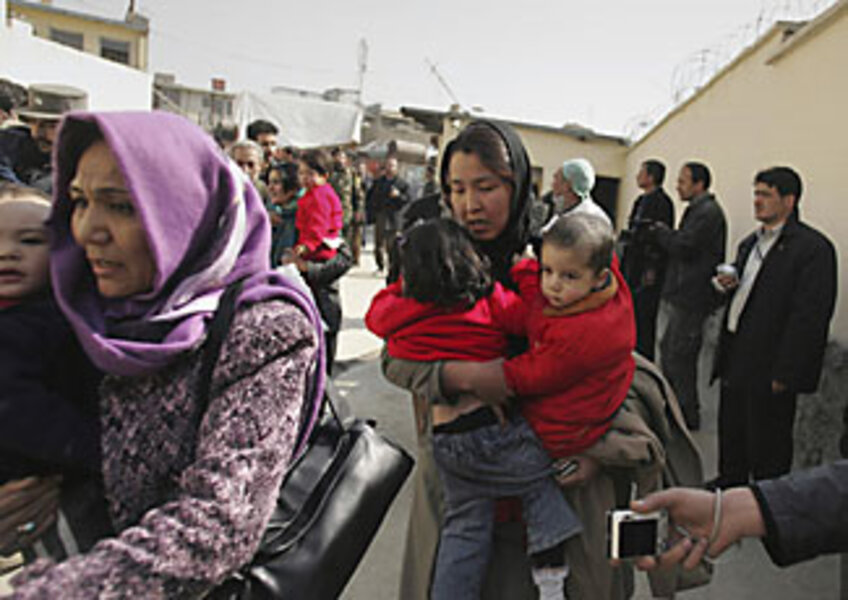Coordinated Kabul assault shows Taliban strength
Loading...
| Kabul, Afghanistan
Insurgents attacked three government offices in Kabul on Wednesday, killing at least 26 and wounding nearly 60. The assault was one of the most complex and daring to take place in the Afghan capital since 2001.
Five armed militants stormed the Ministry of Justice building, in a crowded section of downtown, killing some workers and taking others hostage. Afghan security forces exchanged gunfire for hours before freeing the hostages and killing all of the insurgents. At the same time, suicide bombers assailed a government prison affairs office in the north of the city, while a gunman opened fire outside the education ministry before being killed by police.
The attacks come as the Obama administration is reviewing US strategy in Afghanistan. US special representative Richard Holbrooke is due to visit Kabul Thursday from Pakistan as part of a South Asian tour, and President Obama is expected to decide within days whether to send as many as 30,000 more troops to Afghanistan.
Major incidents like this will certainly affect the debate in Washington, says Waliullah Rahmani, an expert on the insurgency with the Kabul Center for Strategic Studies. "If the insurgents can continually strike at the heart of the heavily fortified capital," he says, "it undermines Washington's faith in the Afghan government to provide security and could push them to send many more troops."
More high-profile assaults in Kabul
Wednesday's attack is the latest in a series of high-profile assaults in Kabul. In January, a car bomb detonated near the German Embassy, killing civilians and US soldiers. Last July, a car bomb targeted the Indian Embassy, killing at least 50 people. Gunmen tried to assassinate President Hamid Karzai last spring and stormed a luxury hotel early last year. In most of these cases, the insurgents were able to circumvent tight security.
On Wednesday, the gunmen were carrying large amounts of weaponry – including knives, grenade launchers, Kalashnikovs, and suicide vests – according to Afghan security officials.
"It concerns me that the enemy is able to bring explosives into the city, despite the security," says Interior Minister Mohammad Hanif Atmar.
While parts of the south and east of the country are not under Afghan control, Kabul has remained a government stronghold. The periodic attacks here are creating a sense of insecurity, analysts say, and pose a challenge to US strategy since the city already has a large concentration of security forces.
"These incidents are a psychological blow to the Afghan government and its allies," says Mr. Rahmani, "since they create the impression that the Taliban and other groups are able to strike anywhere."
Kabul Province saw a 43 percent increase in insurgent-initiated incidents over the past year, according to numbers compiled by Sami Kovanen, a security analyst.
The insurgents periodically unveil new tactics, says Rahmani. Most of Wednesday's attackers adopted a new look, according to witnesses. Some were clean-shaven and wore Western-style clothes, unlike past attackers, who wore traditional Afghan clothing and sported beards.
Assaults in the capital are also becoming more complicated. Wednesday's offensive involved at least eight insurgents in three different parts of the city, requiring considerable planning and coordination. "This is the hallmark of the Haqqani network," says Rahmani, referring to the guerrilla network headed by Jalalhuddin Haqqani and thought to be close to Al Qaeda. "The Haqqani attacks tend to be complex and are growing ever more so."
Officials blame the Haqqani network for most of the high-profile attacks in Kabul in the past year, such as the car bombing at the Indian Embassy. The group counts a number of foreign fighters among its ranks and is generally considered more extremist than the Taliban in their tactics and political outlook.
Nonetheless, the Taliban and the Haqqani network sometimes coordinate attacks, officials say. A Taliban spokesman took credit for Wednesday's assault, saying that they were in retaliation for the Afghan government's harsh treatment of prisoners. (The Haqqani network does not have a spokesman.)
Retaliation for prison abuse?
Two of the besieged sites – the Ministry of Justice and the government office that regulated prisons – oversee the penitentiary system. Afghanistan's prisons house hundreds of captured Taliban and other insurgent members, many of whom allege that authorities torture them. In December, scores of Taliban prisoners sewed their mouths shut and went on a hunger strike to protest ill treatment. Some Taliban members claim to have been falsely imprisoned, and say they turned against the government only after experiencing abuse in the prisons.
Officials with the Afghan security services say that Taliban fighters exaggerate claims of abuse, and that harsh measures are sometimes necessary to extract valuable intelligence. "The Taliban are the ones who are brutal and indiscriminately kill civilians," says Mr. Atmar, the Interior minister. "We are trying to do our job and protect people."





